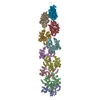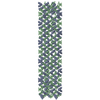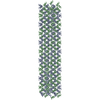+ Open data
Open data
- Basic information
Basic information
| Entry | Database: PDB / ID: 3iky | ||||||
|---|---|---|---|---|---|---|---|
| Title | Structural model of ParM filament in the open state by cryo-EM | ||||||
 Components Components | Plasmid segregation protein parM | ||||||
 Keywords Keywords |  STRUCTURAL PROTEIN / polymorphic protein polymers / STRUCTURAL PROTEIN / polymorphic protein polymers /  Plasmid / Plasmid partition Plasmid / Plasmid partition | ||||||
| Function / homology | Plasmid segregation protein ParM/StbA / : / Plasmid segregation protein ParM, N-terminal / Plasmid segregation protein ParM, C-terminal / ParM-like / plasmid partitioning /  ATPase, nucleotide binding domain / identical protein binding / Plasmid segregation protein ParM ATPase, nucleotide binding domain / identical protein binding / Plasmid segregation protein ParM Function and homology information Function and homology information | ||||||
| Biological species |   Escherichia coli (E. coli) Escherichia coli (E. coli) | ||||||
| Method |  ELECTRON MICROSCOPY / helical reconstruction / ELECTRON MICROSCOPY / helical reconstruction /  cryo EM / Resolution: 18 Å cryo EM / Resolution: 18 Å | ||||||
 Authors Authors | Galkin, V.E. / Orlova, A. / Rivera, C. / Mullins, R.D. / Egelman, E.H. | ||||||
 Citation Citation |  Journal: Structure / Year: 2009 Journal: Structure / Year: 2009Title: Structural polymorphism of the ParM filament and dynamic instability. Authors: Vitold E Galkin / Albina Orlova / Chris Rivera / R Dyche Mullins / Edward H Egelman /  Abstract: Segregation of the R1 plasmid in bacteria relies on ParM, an actin homolog that segregates plasmids by switching between cycles of polymerization and depolymerization. We find similar polymerization ...Segregation of the R1 plasmid in bacteria relies on ParM, an actin homolog that segregates plasmids by switching between cycles of polymerization and depolymerization. We find similar polymerization kinetics and stability in the presence of either ATP or GTP and a 10-fold affinity preference for ATP over GTP. We used electron cryo-microscopy to evaluate the heterogeneity within ParM filaments. In addition to variable twist, ParM has variable axial rise, and both parameters are coupled. Subunits in the same ParM filaments can exist in two different structural states, with the nucleotide-binding cleft closed or open, and the bound nucleotide biases the distribution of states. The interface between protomers is different between these states, and in neither state is it similar to F-actin. Our results suggest that the closed state of the cleft is required but not sufficient for ParM polymerization, and provide a structural basis for the dynamic instability of ParM filaments. | ||||||
| History |
|
- Structure visualization
Structure visualization
| Movie |
 Movie viewer Movie viewer |
|---|---|
| Structure viewer | Molecule:  Molmil Molmil Jmol/JSmol Jmol/JSmol |
- Downloads & links
Downloads & links
- Download
Download
| PDBx/mmCIF format |  3iky.cif.gz 3iky.cif.gz | 629.9 KB | Display |  PDBx/mmCIF format PDBx/mmCIF format |
|---|---|---|---|---|
| PDB format |  pdb3iky.ent.gz pdb3iky.ent.gz | 509.1 KB | Display |  PDB format PDB format |
| PDBx/mmJSON format |  3iky.json.gz 3iky.json.gz | Tree view |  PDBx/mmJSON format PDBx/mmJSON format | |
| Others |  Other downloads Other downloads |
-Validation report
| Arichive directory |  https://data.pdbj.org/pub/pdb/validation_reports/ik/3iky https://data.pdbj.org/pub/pdb/validation_reports/ik/3iky ftp://data.pdbj.org/pub/pdb/validation_reports/ik/3iky ftp://data.pdbj.org/pub/pdb/validation_reports/ik/3iky | HTTPS FTP |
|---|
-Related structure data
| Related structure data |  5129MC  5128C  3ikuC C: citing same article ( M: map data used to model this data |
|---|---|
| Similar structure data |
- Links
Links
- Assembly
Assembly
| Deposited unit | 
|
|---|---|
| 1 |
|
- Components
Components
| #1: Protein | Mass: 35804.375 Da / Num. of mol.: 12 Source method: isolated from a genetically manipulated source Source: (gene. exp.)   Escherichia coli (E. coli) / Gene: parM, stbA / Production host: Escherichia coli (E. coli) / Gene: parM, stbA / Production host:   Escherichia coli (E. coli) / References: UniProt: P11904 Escherichia coli (E. coli) / References: UniProt: P11904 |
|---|
-Experimental details
-Experiment
| Experiment | Method:  ELECTRON MICROSCOPY ELECTRON MICROSCOPY |
|---|---|
| EM experiment | Aggregation state: FILAMENT / 3D reconstruction method: helical reconstruction |
- Sample preparation
Sample preparation
| Component | Name: ParM Filament in Open State / Type: COMPLEX |
|---|---|
| Specimen | Embedding applied: NO / Shadowing applied: NO / Staining applied : NO / Vitrification applied : NO / Vitrification applied : YES : YES |
Vitrification | Cryogen name: ETHANE |
- Electron microscopy imaging
Electron microscopy imaging
| Experimental equipment |  Model: Tecnai F20 / Image courtesy: FEI Company |
|---|---|
| Microscopy | Model: FEI TECNAI F20 |
| Electron gun | Electron source : :  FIELD EMISSION GUN / Accelerating voltage: 200 kV / Illumination mode: FLOOD BEAM FIELD EMISSION GUN / Accelerating voltage: 200 kV / Illumination mode: FLOOD BEAM |
| Electron lens | Mode: BRIGHT FIELD Bright-field microscopy Bright-field microscopy |
| Radiation | Protocol: SINGLE WAVELENGTH / Monochromatic (M) / Laue (L): M |
| Radiation wavelength | Relative weight: 1 |
- Processing
Processing
3D reconstruction | Method: IHRSR / Resolution: 18 Å / Nominal pixel size: 2.38 Å / Actual pixel size: 2.38 Å / Symmetry type: HELICAL | ||||||||||||
|---|---|---|---|---|---|---|---|---|---|---|---|---|---|
| Refinement step | Cycle: LAST
|
 Movie
Movie Controller
Controller











 PDBj
PDBj